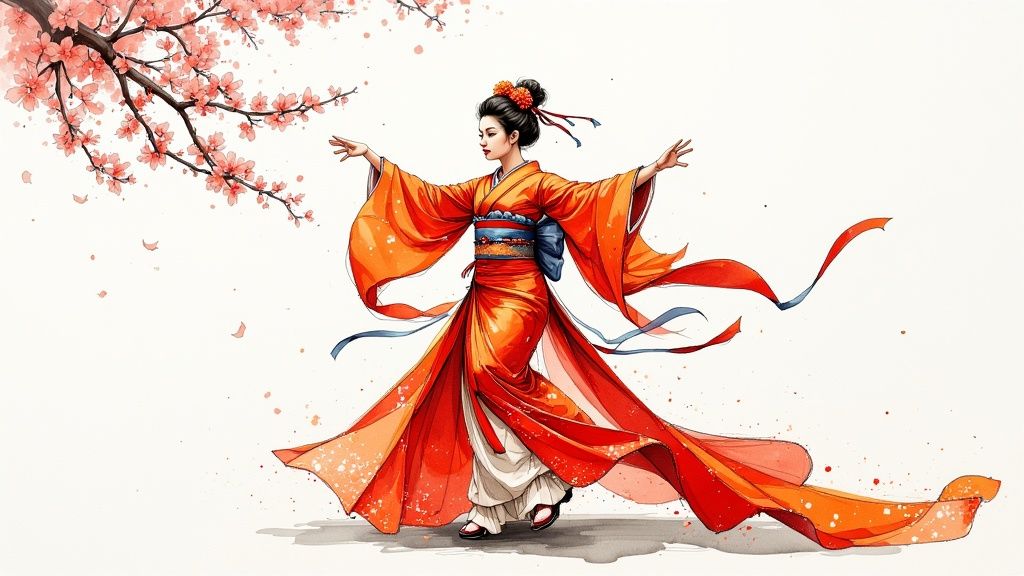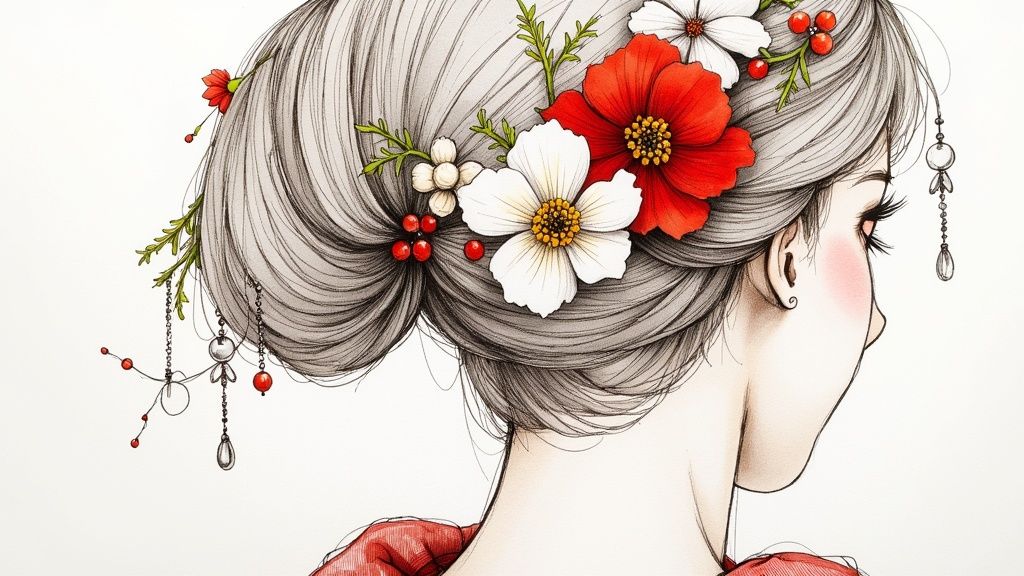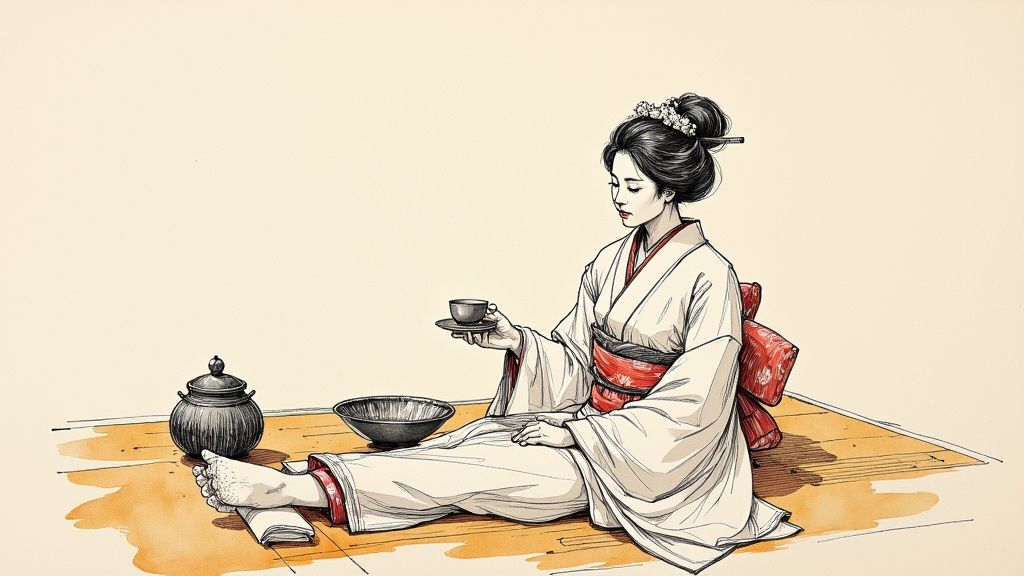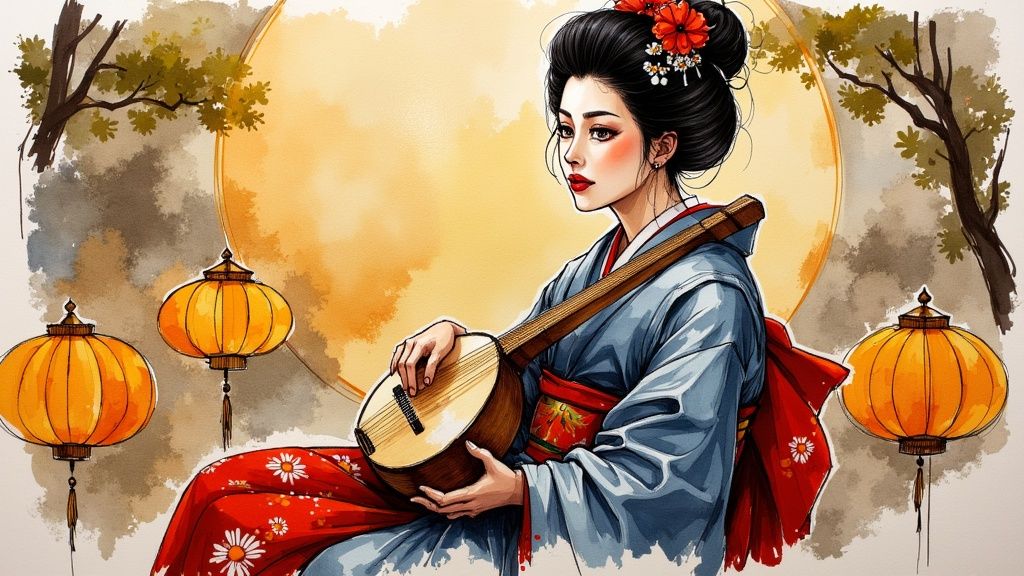The Surprising Evolution of Japan's Geisha Tradition

When you picture a geisha, you likely envision the iconic white makeup, ornate kimono, and elegant hairstyle that have become synonymous with Japanese culture. Yet the history of geisha reveals an unexpected beginning – one that started not with women, but with men.
From Male Entertainers to Female Artists: A Shift in Roles
The geisha tradition began around 1730 with male performers called taikomochi or hōkan. These men worked alongside high-ranking courtesans (oiran) in Japan's pleasure districts, providing musical entertainment and witty conversation to keep guests engaged. They would play instruments during gatherings and use humor to create a lively atmosphere.
It wasn't until 1751 that the first female geisha emerged on the scene. These women started primarily as dancers (odoriko) and musicians who played the shamisen. By 1780, female geisha had become so popular that they completely overshadowed their male counterparts. Their skill in arts like dance, music, and conversation earned them recognition as accomplished entertainers in their own right.
The Edo and Meiji Periods: Defining the Geisha Identity
During the Edo Period (1603-1886), strict rules governed geisha conduct. They were banned from forming personal relationships with clients to avoid competing with the courtesans. However, as the courtesan tradition declined in the Meiji Period (1868-1912), geisha stepped into a more prominent role in Japanese society. They became sought-after entertainers at corporate events and government functions. By the 1920s, Japan's geisha community had grown to roughly 80,000 members – a clear sign of their important place in Japanese hospitality. For more details about this rich history, check out our article on The Geisha of Japan: Mired in Myth, Steeped in Tradition.
Adapting to Modernity: Geisha Culture in the 20th Century and Beyond
The 20th century brought major changes as Western influence grew and World War II took its toll. The hanamachi (geisha districts) struggled to survive wartime hardships and new post-war regulations. The once-thriving geisha population dropped dramatically, with only a small fraction remaining today. Yet through these challenges, geisha have shown remarkable resilience, finding ways to preserve their art while adapting to modern times.
The evolution from male entertainers to highly skilled female artists reveals how geisha culture has grown and changed while maintaining its core traditions. Their story shows how cultural practices can endure by striking a balance between preserving the past and embracing change.
Mastering the Art: Inside a Geisha's Training Journey

Becoming a geisha in Japan requires extraordinary dedication and many years of intense training. The journey shapes young apprentices into accomplished artists who embody Japan's rich cultural heritage through music, dance, and social refinement. Let's explore the fascinating path these women take to master their craft.
The Apprenticeship: From Maiko to Geiko
An aspiring geisha begins her journey at an okiya, a traditional geisha house where she trains as a maiko (apprentice). Each day brings new lessons in Japanese arts, proper etiquette, and social graces – skills essential for entertaining guests. A typical day might find a maiko practicing the precise movements of a tea ceremony, learning to fold her kimono just so, or studying proper conversation techniques. These foundational skills form the bedrock of a geisha's education.
A Symphony of Skills: Music, Dance, and Beyond
Music and dance stand at the heart of a geisha's education. Students spend countless hours mastering traditional instruments like the shamisen (three-stringed lute) and koto (thirteen-stringed zither), developing an intimate understanding of classical Japanese melodies. Dance training demands equal attention, as apprentices perfect the subtle hand gestures and graceful movements that characterize traditional performances. Beyond performing arts, geisha study calligraphy, flower arranging (ikebana), and the art of stimulating conversation. This blend of talents allows them to create memorable experiences for their guests.
The Shimada Hairstyle: A Symbol of Dedication
The distinctive shimada hairstyle worn by geisha represents both artistry and status. This complex updo, decorated with ornate combs and pins, requires significant skill to create and maintain. For apprentices, mastering this hairstyle symbolizes their growing expertise. The style itself evolves subtly as a maiko progresses, with slight variations in ornaments and styling marking her advancement through different stages of training.
Modern Adaptations: Balancing Tradition and Innovation
While maintaining centuries-old traditions, today's geisha community thoughtfully adapts to contemporary life. Some geisha now share glimpses of their art through social media, helping new audiences appreciate their cultural heritage. Yet the core elements remain unchanged – the years of disciplined practice, the pursuit of artistic excellence, and the preservation of Japanese cultural arts continue to define the path from maiko to geiko. This careful balance ensures that geisha traditions stay relevant while retaining their timeless essence.
Life Within the Hanamachi: Where Tradition Meets Reality

A geisha's journey reaches its true beginning when she enters the hanamachi, the traditional geisha district of Japan. These districts are living museums where centuries-old traditions blend seamlessly with daily life. Each hanamachi operates as its own small world, carefully maintaining the practices and arts that make geisha culture unique while adapting to present-day realities.
The Okiya: The Heart of the Hanamachi
The okiya, or geisha house, stands at the center of life in the hanamachi. These establishments serve multiple purposes – they're homes, schools, and businesses rolled into one. At the helm is the okā-san (mother), typically a former geisha who now manages the household. She guides young apprentices, handles business matters, and maintains the delicate social connections that keep the okiya running. This family-like structure creates strong bonds between residents while ensuring traditional knowledge passes naturally from one generation to the next.
The Role of Senior Geisha: Mentorship and Guidance
Experienced geisha, known as geiko, serve as essential mentors within the hanamachi. They take young maiko (apprentices) under their wing, sharing not just performance skills but also the subtle arts of conversation and social grace that define a true geisha. Beyond teaching, senior geisha maintain important relationships with clients and represent their okiya at formal occasions, helping secure the district's financial stability.
Economic Sustainability: Balancing Tradition and Modernity
Today's hanamachi face real challenges in staying financially viable. The expenses of training new geisha, maintaining traditional wardrobes, and keeping up historic buildings are significant. Some districts have found creative solutions while respecting tradition. For instance, certain okiya now maintain careful social media presences to share their culture with a broader audience. This thoughtful adaptation helps these communities continue their work while staying true to their core values.
Preserving Cultural Significance: A Community Effort
The hanamachi puts great emphasis on preserving both its tangible and intangible heritage. Many districts occupy historically significant areas, and their buildings themselves are living pieces of architectural history. The okiya carefully maintain traditional clothing, hairstyles, and customs. Most importantly, the practice of passing knowledge directly from teacher to student keeps the true spirit of geisha culture alive. Through this ongoing cycle of learning and teaching, each new generation adds their own chapter to this enduring story of Japanese artistry.
Navigating Modern Challenges in a Traditional Art

Japan's hanamachi districts, the historic heart of geisha culture, find themselves at a crossroads between preserving ancient traditions and adapting to modern realities. These cultural centers must carefully consider how to stay true to their roots while remaining sustainable in contemporary society. It's a delicate balance that requires thoughtful solutions and community support.
The Economic Reality of Preserving Geisha Culture
Running a hanamachi comes with significant costs that can strain even well-established districts. Each kimono can cost thousands of dollars, while traditional instruments like the shamisen require regular maintenance and expert care. The okiya (geisha houses) themselves need constant upkeep to maintain their historic character. Beyond physical assets, the extensive training period for new geisha – often lasting five years or more – represents a major financial commitment. These practical challenges make it harder to attract newcomers to the profession, especially when compared to conventional career paths.
Attracting New Apprentices: Bridging the Generational Gap
Becoming a geisha requires remarkable dedication – apprentices must master traditional arts while following strict rules that can seem out of step with modern life. Yet some hanamachi have found success by actively reaching out to young women through educational programs that highlight the depth and beauty of geisha arts. Forward-thinking okiya now allow some flexibility in training schedules and living arrangements while maintaining high standards for the art form itself. This balanced approach helps draw in talented apprentices who might otherwise not consider this path.
Embracing Technology: A Tool for Preservation and Outreach
While staying grounded in tradition, select hanamachi have begun carefully using modern tools to support their work. Some districts maintain thoughtful social media accounts that offer glimpses into geisha culture while respecting its private nature. These platforms help educate the public about genuine geisha arts and traditions. The key is using technology selectively and purposefully – always in service of preserving authentic geisha culture rather than changing it.
Sustaining the Future: Collaboration and Innovation
The path forward for geisha communities depends on strong partnerships between okiya, cultural preservation groups, and local governments. By sharing knowledge and resources, these organizations can better tackle shared challenges. Building connections with international arts and cultural institutions also creates opportunities for education and support. Success requires finding ways to adapt thoughtfully while protecting the core traditions that make geisha culture unique and meaningful. It's an ongoing process of careful evolution that honors the past while securing a future for this remarkable art form.
Beyond the Stereotypes: Understanding Authentic Geisha Culture
When people think of geisha, their minds often jump to romanticized images from movies and books that don't match reality. To truly understand this respected profession, we need to look past these surface-level portrayals and examine the authentic traditions, skills, and artistry that define geisha culture in Japan. This exploration will help separate truth from fiction while showing how these artists maintain their cultural heritage in modern times.
Unveiling the Artistry: More Than Meets the Eye
At its core, geisha culture celebrates the mastery of traditional Japanese arts. While the striking white makeup and elegant kimono catch the eye, the true essence lies in years of dedicated training. A geisha must excel in multiple art forms – from the graceful movements of traditional dance to the precise techniques of the tea ceremony. They study ikebana (flower arranging), perfect their calligraphy, and develop exceptional conversational abilities. This comprehensive artistic education often requires 5-7 years of intense study before a trainee can debut as a full geisha.
Dispelling Misconceptions: Separating Fact From Fiction
One harmful myth that persists is the incorrect association between geisha and sex work. In reality, geisha are accomplished entertainers who create refined social experiences through their artistic performances and engaging conversation. They train extensively to maintain the highest standards of traditional Japanese arts and etiquette. Another common misunderstanding is that geisha only exist in Kyoto. While Kyoto's geisha districts are famous, vibrant geisha communities thrive in other Japanese cities, each with distinct local customs that add richness to the overall tradition.
The Modern Geisha: Navigating a Changing World
Today's geisha thoughtfully blend time-honored traditions with contemporary realities. They work to maintain the integrity of their art while addressing modern challenges and expectations. Some geisha now share glimpses of their world through social media, helping educate the public about their profession's true nature. Yet they carefully balance this openness with preserving the mystery and exclusivity that have long characterized their art form.
Preserving Cultural Heritage: The Importance of Accurate Representation
Getting the story right matters deeply when discussing geisha culture. False stereotypes not only disrespect these artists but also diminish understanding of their vital role in preserving Japanese cultural arts. Like master painters or musicians who spend years perfecting their craft, geisha dedicate themselves to keeping traditional art forms alive through daily practice and performance. By learning to see geisha as the skilled cultural practitioners they are, we can better appreciate their ongoing contributions to Japanese heritage and support the continuation of their meaningful work for future generations.
Safeguarding Tomorrow's Cultural Heritage
The time-honored traditions of geisha face a fundamental challenge – how to preserve their rich cultural legacy while adapting to modern life. Their art form has endured for centuries through careful stewardship, but maintaining this delicate heritage requires thoughtful approaches that respect tradition while embracing new possibilities.
Passing the Baton: Educating Future Generations
At the heart of preserving geisha culture is the passing of knowledge from experienced practitioners to the next generation. The traditional model, where seasoned geiko guide young maiko apprentices within the hanamachi districts, remains essential. But this teaching now extends beyond the okiya houses through carefully designed educational programs that introduce more people to geisha arts – from dance and music to the subtle art of conversation and proper etiquette. These programs create new paths for aspiring geisha while helping more people understand and value this cultural practice.
Adapting to Modernity: Embracing Technology and Innovation
While staying true to their roots, some geisha communities are carefully exploring how modern tools can support their art. Select hanamachi now maintain social media presences, offering carefully curated glimpses into their world and helping correct misunderstandings about geisha culture. Some okiya houses have also begun adjusting their training approaches, finding ways to accommodate modern schedules without compromising their high artistic standards. This thoughtful adaptation helps attract new apprentices who might otherwise hesitate to pursue such a demanding path.
Fostering International Appreciation: Building Global Bridges
Growing international recognition plays a key role in supporting geisha communities. Working with arts organizations abroad allows geisha to showcase their talents globally, creating both financial support and deeper appreciation for their traditions. Well-managed cultural tourism also brings resources to the hanamachi while encouraging meaningful cross-cultural exchange. The key is maintaining authenticity – ensuring these interactions enrich both visitors and the geisha community.
Practical Examples of Preservation in Action
Many hanamachi districts demonstrate effective preservation work in action. Some are creating digital archives of their history and artistic practices, ensuring these traditions are documented for future generations. Others partner with local governments to maintain historic buildings that are central to geisha life. These practical steps, combining respected traditions with careful modernization, help ensure this remarkable cultural practice continues to flourish.
Ready to delve deeper into Japanese culture? Explore the world of matcha and its significance in Japanese traditions at matcha-tea.com. Click here to discover more: https://matcha-tea.com
